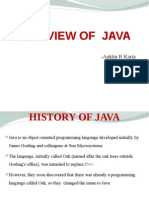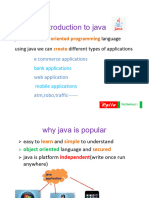0% found this document useful (0 votes)
24 views29 pages? Summary of Java Programming
The document provides an introduction to Java, covering its features, editions, and the basics of Object-Oriented Programming (OOP). It explains the structure of Java programs, data types, variables, methods, classes, objects, constructors, decision-making, and loops. Key concepts such as encapsulation, inheritance, polymorphism, and abstraction are highlighted, along with advantages and common mistakes in Java programming.
Uploaded by
thomasjames3952Copyright
© © All Rights Reserved
We take content rights seriously. If you suspect this is your content, claim it here.
Available Formats
Download as PDF, TXT or read online on Scribd
0% found this document useful (0 votes)
24 views29 pages? Summary of Java Programming
The document provides an introduction to Java, covering its features, editions, and the basics of Object-Oriented Programming (OOP). It explains the structure of Java programs, data types, variables, methods, classes, objects, constructors, decision-making, and loops. Key concepts such as encapsulation, inheritance, polymorphism, and abstraction are highlighted, along with advantages and common mistakes in Java programming.
Uploaded by
thomasjames3952Copyright
© © All Rights Reserved
We take content rights seriously. If you suspect this is your content, claim it here.
Available Formats
Download as PDF, TXT or read online on Scribd
/ 29























































































